Abstract
The possible alterations in the pharmacokinetics and protein binding behavior of the beta-lactam antibiotic cefazolin (CEZ) were investigated in endotoxemic rats induced by Klebsiella pneumoniae O3 lipopolysaccharide (LPS). LPS (250 micrograms/kg of body weight) was infused for 20 to 30 min 2 h before an intravenous administration of CEZ (20 mg/kg). Significant decreases in systemic clearance and renal clearance of CEZ were observed in LPS-treated rats without any changes in fraction of urinary excretion in unchanged CEZ (> 0.8). The volume of distribution at steady state showed a tendency to increase. The protein binding parameters of CEZ, the binding capacity, and number of binding sites on the albumin molecule were decreased by LPS, whereas the dissociation constant did not change. Significant decreases in systemic and renal clearances for unbound CEZ were observed in LPS-treated rats. The glomerular filtration rate estimated as inulin clearance was also decreased by LPS. The ratio of renal clearance of unbound CEZ to glomerular filtration rate (clearance ratio) dropped to 70% of that in control rats, and the net tubular secretion of CEZ was also dramatically reduced. The present study suggests that LPS has an effect on the pharmacokinetics of CEZ by changes which occur in renal handling and protein binding.
Full text
PDF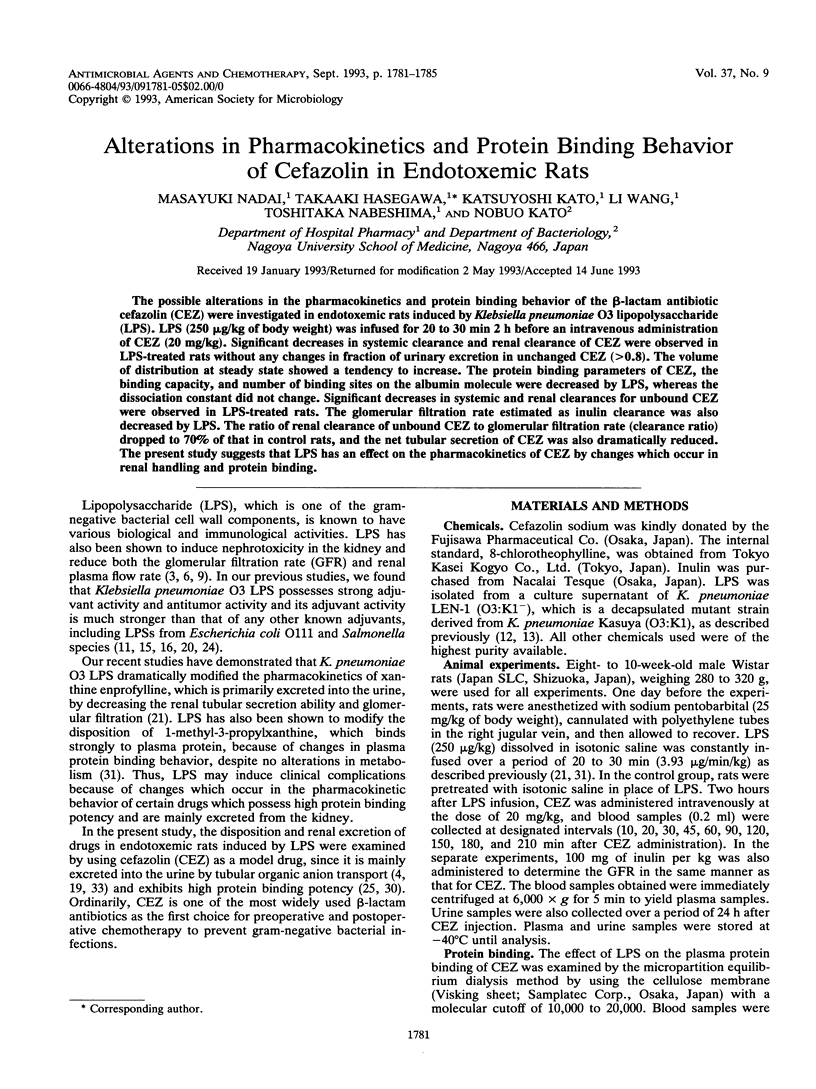
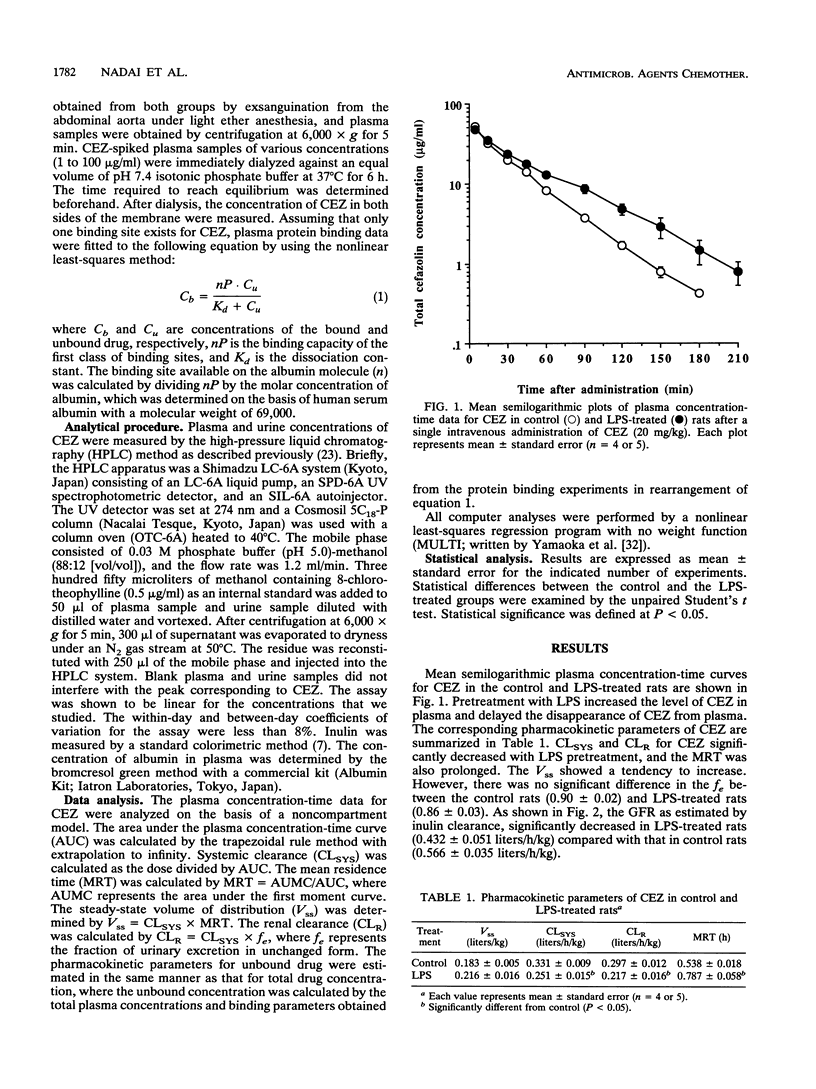
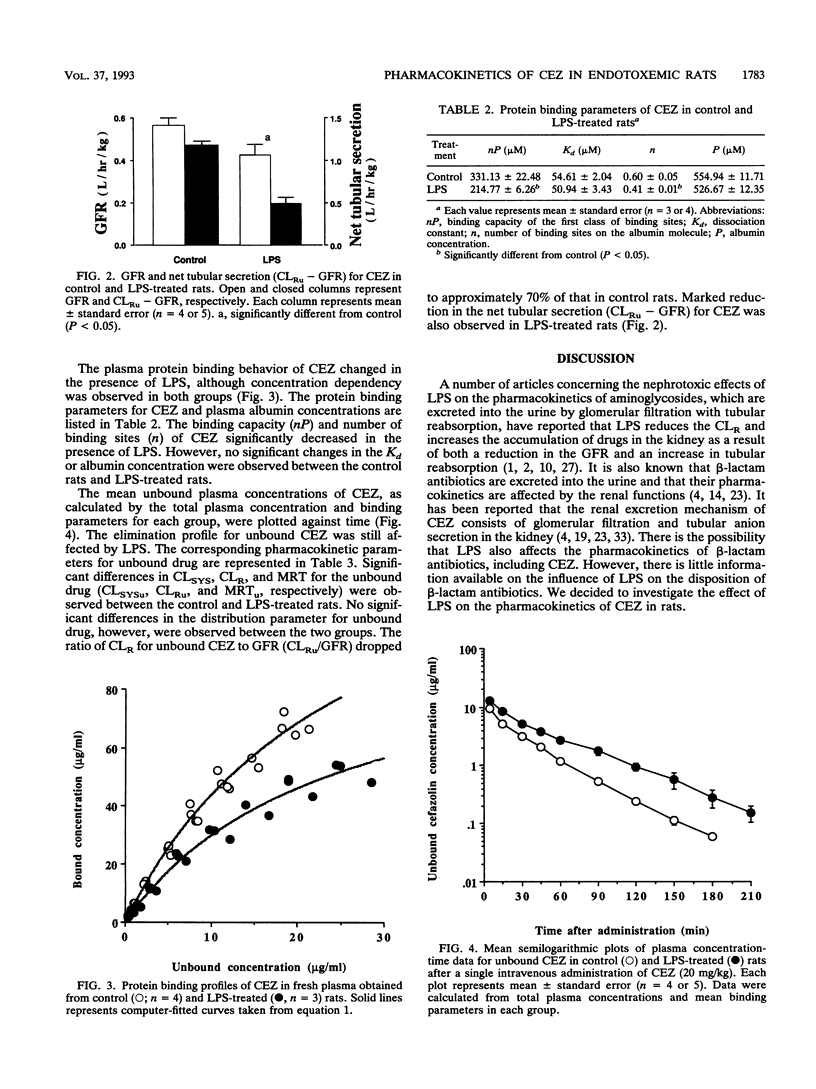
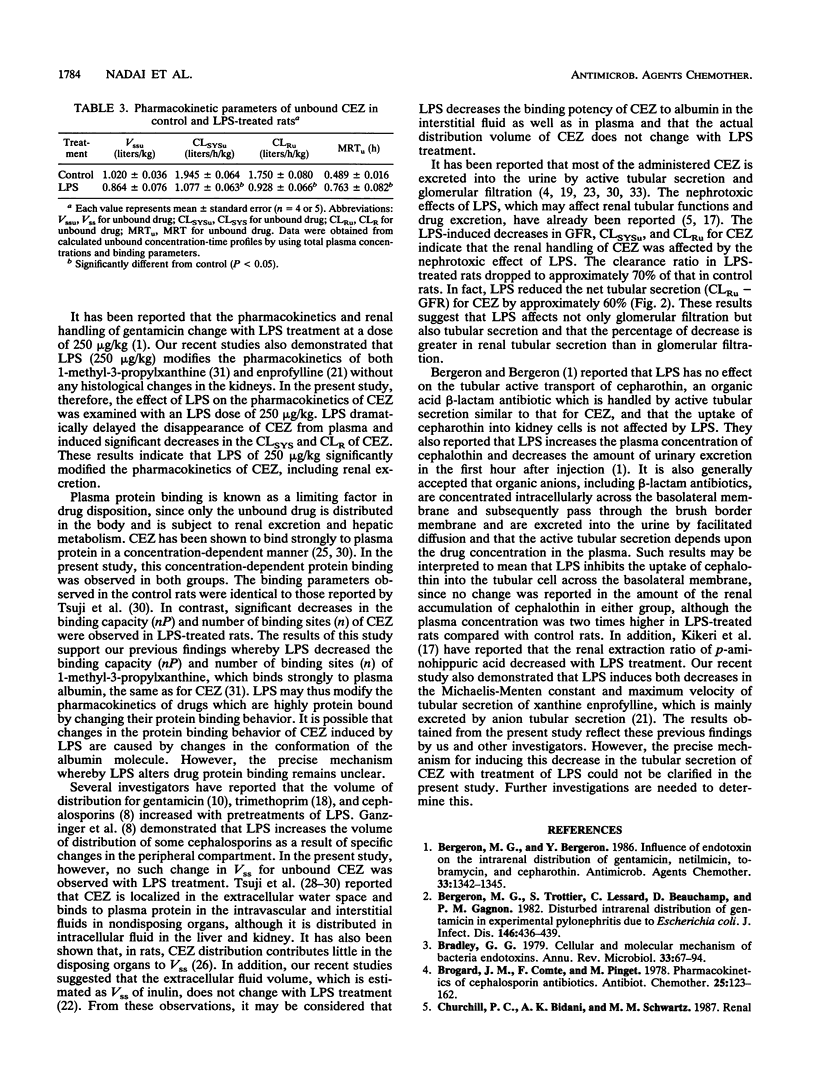
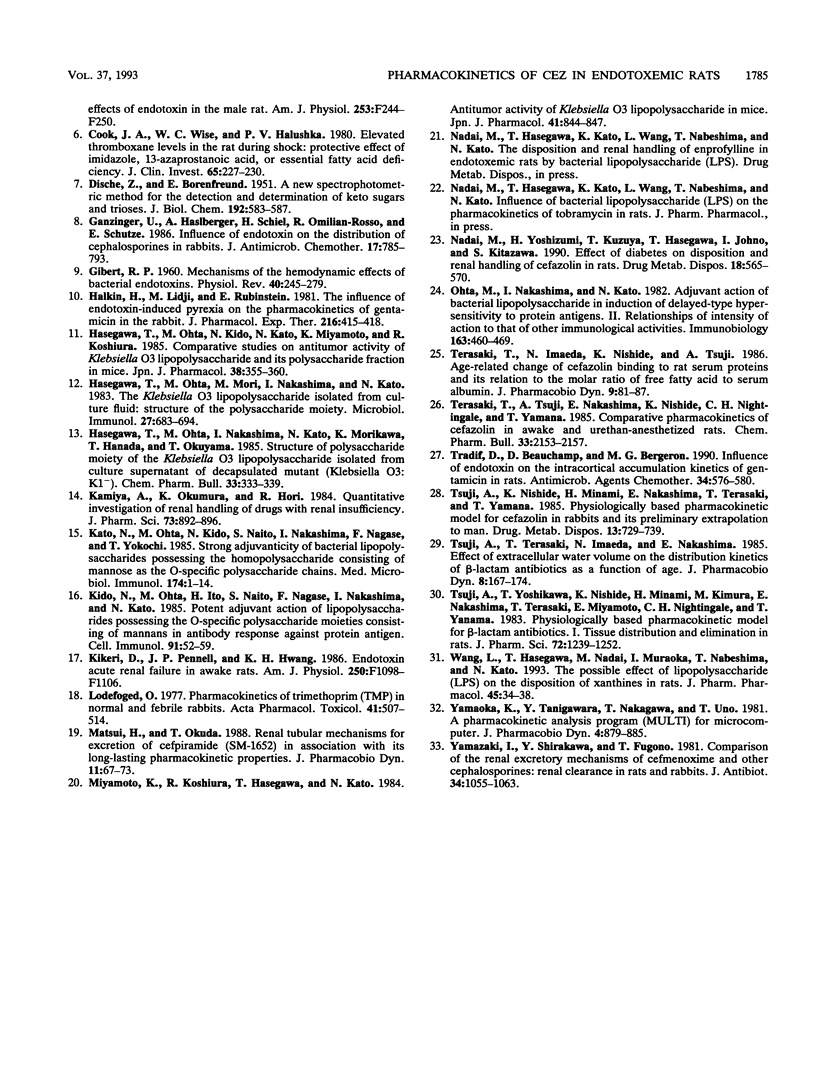
Selected References
These references are in PubMed. This may not be the complete list of references from this article.
- Bergeron M. G., Bergeron Y., Tardif M., Marchand S., Beauchamp D. Influence of indomethacin on the intrarenal uptake of gentamicin in endotoxemic rats. Antimicrob Agents Chemother. 1989 Aug;33(8):1342–1345. doi: 10.1128/aac.33.8.1342. [DOI] [PMC free article] [PubMed] [Google Scholar]
- Bergeron M. G., Trottier S., Lessard C., Beauchamp D., Gagnon P. M. Disturbed intrarenal distribution of gentamicin in experimental pyelonephritis due to Escherichia coli. J Infect Dis. 1982 Sep;146(3):436–439. doi: 10.1093/infdis/146.3.436. [DOI] [PubMed] [Google Scholar]
- Bradley S. G. Cellular and molecular mechanisms of action of bacterial endotoxins. Annu Rev Microbiol. 1979;33:67–94. doi: 10.1146/annurev.mi.33.100179.000435. [DOI] [PubMed] [Google Scholar]
- Brogard J. M., Comte F., Pinget M. Pharmacokinetics of cephalosporin antibiotics. Antibiot Chemother (1971) 1978;25:123–162. doi: 10.1159/000401060. [DOI] [PubMed] [Google Scholar]
- Churchill P. C., Bidani A. K., Schwartz M. M. Renal effects of endotoxin in the male rat. Am J Physiol. 1987 Aug;253(2 Pt 2):F244–F250. doi: 10.1152/ajprenal.1987.253.2.F244. [DOI] [PubMed] [Google Scholar]
- Cook J. A., Wise W. C., Halushka P. V. Elevated thromboxane levels in the rat during endotoxic shock: protective effects of imidazole, 13-azaprostanoic acid, or essential fatty acid deficiency. J Clin Invest. 1980 Jan;65(1):227–230. doi: 10.1172/JCI109655. [DOI] [PMC free article] [PubMed] [Google Scholar]
- DISCHE Z., BORENFREUND E. A new spectrophotometric method for the detection and determination of keto sugars and trioses. J Biol Chem. 1951 Oct;192(2):583–587. [PubMed] [Google Scholar]
- GILBERT R. P. Mechanisms of the hemodynamic effects of endotoxin. Physiol Rev. 1960 Apr;40:245–279. doi: 10.1152/physrev.1960.40.2.245. [DOI] [PubMed] [Google Scholar]
- Ganzinger U., Haslberger A., Schiel H., Omilian-Rosso R., Schütze E. Influence of endotoxin on the distribution of cephalosporins in rabbits. J Antimicrob Chemother. 1986 Jun;17(6):785–793. doi: 10.1093/jac/17.6.785. [DOI] [PubMed] [Google Scholar]
- Halkin H., Lidji M., Rubinstein E. The influence of endotoxin-induced pyrexia on the pharmacokinetics of gentamicin in the rabbit. J Pharmacol Exp Ther. 1981 Feb;216(2):415–418. [PubMed] [Google Scholar]
- Hasegawa T., Ohta M., Kido N., Kato N., Miyamoto K., Koshiura R. Comparative studies on antitumor activity of Klebsiella O3 lipopolysaccharide and its polysaccharide fraction in mice. Jpn J Pharmacol. 1985 Aug;38(4):355–360. doi: 10.1254/jjp.38.355. [DOI] [PubMed] [Google Scholar]
- Hasegawa T., Ohta M., Mori M., Nakashima I., Kato N. The Klebsiella O3 lipopolysaccharide isolated from culture fluid: structure of the polysaccharide moiety. Microbiol Immunol. 1983;27(8):683–694. doi: 10.1111/j.1348-0421.1983.tb00631.x. [DOI] [PubMed] [Google Scholar]
- Hasegawa T., Ohta M., Nakashima I., Kato N., Morikawa K., Harada T., Okuyama T. Structure of the polysaccharide moiety of the Klebsiella O3 lipopolysaccharide isolated from culture supernatant of decapsulated mutant (Klebsiella O3:K1-). Chem Pharm Bull (Tokyo) 1985 Jan;33(1):333–339. doi: 10.1248/cpb.33.333. [DOI] [PubMed] [Google Scholar]
- Kamiya A., Okumura K., Hori R. Quantitative investigation of renal handling of drugs in dogs with renal insufficiency. J Pharm Sci. 1984 Jul;73(7):892–896. doi: 10.1002/jps.2600730708. [DOI] [PubMed] [Google Scholar]
- Kato N., Ohta M., Kido N., Naito S., Nakashima I., Nagase F., Yokochi T. Strong adjuvanticity of bacterial lipopolysaccharides possessing the homopolysaccharides consisting of mannose as the O-specific polysaccharide chains. Med Microbiol Immunol. 1985;174(1):1–14. [PubMed] [Google Scholar]
- Kido N., Ohta M., Ito H., Naito S., Nagase F., Nakashima I., Kato N. Potent adjuvant action of lipopolysaccharides possessing the O-specific polysaccharide moieties consisting of mannans in antibody response against protein antigen. Cell Immunol. 1985 Mar;91(1):52–59. doi: 10.1016/0008-8749(85)90031-0. [DOI] [PubMed] [Google Scholar]
- Kikeri D., Pennell J. P., Hwang K. H., Jacob A. I., Richman A. V., Bourgoignie J. J. Endotoxemic acute renal failure in awake rats. Am J Physiol. 1986 Jun;250(6 Pt 2):F1098–F1106. doi: 10.1152/ajprenal.1986.250.6.F1098. [DOI] [PubMed] [Google Scholar]
- Matsui H., Okuda T. Renal tubular mechanisms for excretion of cefpiramide (SM-1652) in association with its long-lasting pharmacokinetic properties. J Pharmacobiodyn. 1988 Feb;11(2):67–73. doi: 10.1248/bpb1978.11.67. [DOI] [PubMed] [Google Scholar]
- Nadai M., Yoshizumi H., Kuzuya T., Hasegawa T., Johno I., Kitazawa S. Effect of diabetes on disposition and renal handling of cefazolin in rats. Drug Metab Dispos. 1990 Sep-Oct;18(5):565–570. [PubMed] [Google Scholar]
- Ohta M., Nakashima I., Kato N. Adjuvant action of bacterial lipopolysaccharide in induction of delayed-type hypersensitivity to protein antigens. II. Relationships of intensity of the action to that of other immunological activities. Immunobiology. 1982 Dec;163(5):460–469. doi: 10.1016/S0171-2985(82)80060-0. [DOI] [PubMed] [Google Scholar]
- Tardif D., Beauchamp D., Bergeron M. G. Influence of endotoxin on the intracortical accumulation kinetics of gentamicin in rats. Antimicrob Agents Chemother. 1990 Apr;34(4):576–580. doi: 10.1128/aac.34.4.576. [DOI] [PMC free article] [PubMed] [Google Scholar]
- Terasaki T., Imaeda N., Nishide K., Tsuji A. Age-related change of cefazolin binding to rat serum proteins and its relation to the molar ratio of free fatty acid to serum albumin. J Pharmacobiodyn. 1986 Jan;9(1):81–87. doi: 10.1248/bpb1978.9.81. [DOI] [PubMed] [Google Scholar]
- Terasaki T., Tsuji A., Nakashima E., Nishide K., Nightingale C. H., Yamana T. Comparative pharmacokinetics of cefazolin in awake and urethane-anesthetized rats. Chem Pharm Bull (Tokyo) 1985 May;33(5):2153–2157. doi: 10.1248/cpb.33.2153. [DOI] [PubMed] [Google Scholar]
- Tsuji A., Nishide K., Minami H., Nakashima E., Terasaki T., Yamana T. Physiologically based pharmacokinetic model for cefazolin in rabbits and its preliminary extrapolation to man. Drug Metab Dispos. 1985 Nov-Dec;13(6):729–739. [PubMed] [Google Scholar]
- Tsuji A., Terasaki T., Imaeda N., Nishide K., Nakashima E. Effect of extracellular water volume on the distribution kinetics of beta-lactam antibiotics as a function of age. J Pharmacobiodyn. 1985 Mar;8(3):167–174. doi: 10.1248/bpb1978.8.167. [DOI] [PubMed] [Google Scholar]
- Tsuji A., Yoshikawa T., Nishide K., Minami H., Kimura M., Nakashima E., Terasaki T., Miyamoto E., Nightingale C. H., Yamana T. Physiologically based pharmacokinetic model for beta-lactam antibiotics I: Tissue distribution and elimination in rats. J Pharm Sci. 1983 Nov;72(11):1239–1252. doi: 10.1002/jps.2600721103. [DOI] [PubMed] [Google Scholar]
- Wang L., Hasegawa T., Nadai M., Muraoka I., Nabeshima T., Kato N. The effect of lipopolysaccharide on the disposition of xanthines in rats. J Pharm Pharmacol. 1993 Jan;45(1):34–38. doi: 10.1111/j.2042-7158.1993.tb03675.x. [DOI] [PubMed] [Google Scholar]
- Yamaoka K., Tanigawara Y., Nakagawa T., Uno T. A pharmacokinetic analysis program (multi) for microcomputer. J Pharmacobiodyn. 1981 Nov;4(11):879–885. doi: 10.1248/bpb1978.4.879. [DOI] [PubMed] [Google Scholar]
- Yamazaki I., Shirakawa Y., Fugono T. Comparison of the renal excretory mechanisms of cefmenoxime and other cephalosporins: renal clearance in rats and rabbits. J Antibiot (Tokyo) 1981 Aug;34(8):1055–1063. doi: 10.7164/antibiotics.34.1055. [DOI] [PubMed] [Google Scholar]


